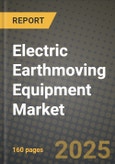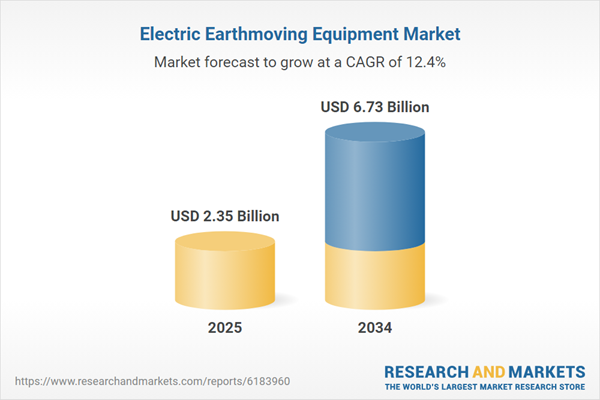Electric Earthmoving Equipment Market
The electric earthmoving equipment market covers battery-electric and tethered/plug-in variants of compact and heavy machines used for excavation, loading, hauling, grading, and materials handling across building construction, roadworks, utilities, mining & quarrying, industrial sites, agriculture/landscaping, and municipal services. Portfolios span mini and midi excavators, compact track/wheel loaders, skid-steers, backhoe loaders, telehandlers, wheel loaders, articulated dumpers, and early-stage dozers and rigid/ADT haulers. Trends converge on high-efficiency drivetrains (permanent-magnet motors, 600-800V architectures), advanced electro-hydraulics with energy recovery, and modular battery packs (LFP and NMC today; sodium-ion/solid-state on the roadmap). Site power is becoming strategic: DC fast charging, battery-swap carts, towable power banks, and temporary microgrids coordinate with jobsite power management to flatten peaks and maintain shift productivity. Procurement is propelled by zero-emission zones, noise limits, ESG targets, indoor/tunnel work where ventilation is costly, and total cost-of-operation advantages from reduced fuel, idle, and maintenance. Competitive dynamics combine global OEMs electrifying core platforms, agile specialists in compact segments, and new entrants (often with strong battery/inverter IP); rental companies are critical channel partners de-risking adoption. Differentiation hinges on duty-cycle match (runtime/charging mix), hydraulic feel, robustness in dust/cold, telematics for energy KPIs, and residual-value programs (battery warranties, leasing). Key challenges include pack weight and cost, charging logistics on greenfield sites, high-load thermal management, and operator change management. Suppliers pairing efficient machines with an ecosystem of chargers, mobile storage, financing, and uptime-focused service are best positioned as electrification scales from pilots to fleet standards.Electric Earthmoving Equipment Market Key Insights
- Compact segments lead commercialization
- Energy architecture sets the ceiling
- Electro-hydraulics close the efficiency gap
- Charging is a system sale
- Tethered and hybrid niches persist
- Rental is the adoption flywheel
- Data and uptime win repeat orders
- Safety and training are differentiators
- Materials and climate durability matter
- Financing and residuals de-risk TCO
Electric Earthmoving Equipment Market Reginal Analysis
North America
Adoption accelerates in urban construction, utilities, and municipal fleets pursuing noise and emissions reductions. Contractors value compact electrics for interior demo and night work; DOT and utility projects pilot larger classes with mobile DC chargers. Rental majors catalyze trials, while cold-weather packages and dealer service density influence brand choice.Europe
Zero-emission jobsite mandates and tight urban workspaces make electric compact equipment a procurement priority. Public tenders reward low noise and verified lifecycle emissions; Scandinavian markets lead with site microgrids and battery-swap. OEMs emphasize CE compliance, telematics for energy reporting, and integrated charger financing through dealers.Asia-Pacific
Scale manufacturing and dense cities support rapid uptake of electric minis and loaders for residential, rail, and utility jobs. Chinese and Korean OEMs push high-value platforms with local battery supply; Australia/New Zealand pilot electrics for mining ancillary tasks. Government incentives and industrial park power access shape charging strategies.Middle East & Africa
Mega-projects and indoor/tunnel work create niche demand for zero-emission machines where ventilation costs are high. Hot-climate durability, sand/dust sealing, and robust thermal management are critical. Temporary microgrids with solar-diesel hybrids gain interest on remote sites; procurement often runs through global contractors and rental fleets.South & Central America
Adoption is selective, led by airports, logistics parks, and municipalities prioritizing noise and air quality. Currency volatility favors rental and OEM financing bundles; reliability and parts availability are decisive. Contractors test compact electrics on indoor and night projects while monitoring TCO versus diesel under local electricity tariffs.Electric Earthmoving Equipment Market Segmentation
By Product
- Dozer
- Excavator
- Loader
- Motor Grader
- Dump Truck
By Propulsion
- Battery Electric Vehicle (BEV)
- Hybrid Electric Vehicle (HEV)
By Battery
- Lithium-ion
- Lead-acid
Key Market players
Volvo Construction Equipment, Caterpillar, Komatsu, Hitachi Construction Machinery, JCB, Bobcat, Wacker Neuson, Liebherr, Hyundai Construction Equipment, Develon, SANY, XCMG, LiuGong, John Deere, CASE Construction EquipmentElectric Earthmoving Equipment Market Analytics
The report employs rigorous tools, including Porter’s Five Forces, value chain mapping, and scenario-based modelling, to assess supply-demand dynamics. Cross-sector influences from parent, derived, and substitute markets are evaluated to identify risks and opportunities. Trade and pricing analytics provide an up-to-date view of international flows, including leading exporters, importers, and regional price trends.
Macroeconomic indicators, policy frameworks such as carbon pricing and energy security strategies, and evolving consumer behaviour are considered in forecasting scenarios. Recent deal flows, partnerships, and technology innovations are incorporated to assess their impact on future market performance.Electric Earthmoving Equipment Market Competitive Intelligence
The competitive landscape is mapped through proprietary frameworks, profiling leading companies with details on business models, product portfolios, financial performance, and strategic initiatives. Key developments such as mergers & acquisitions, technology collaborations, investment inflows, and regional expansions are analyzed for their competitive impact. The report also identifies emerging players and innovative startups contributing to market disruption.
Regional insights highlight the most promising investment destinations, regulatory landscapes, and evolving partnerships across energy and industrial corridors.Countries Covered
- North America - Electric Earthmoving Equipment market data and outlook to 2034
- United States
- Canada
- Mexico
- Europe - Electric Earthmoving Equipment market data and outlook to 2034
- Germany
- United Kingdom
- France
- Italy
- Spain
- BeNeLux
- Russia
- Sweden
- Asia-Pacific - Electric Earthmoving Equipment market data and outlook to 2034
- China
- Japan
- India
- South Korea
- Australia
- Indonesia
- Malaysia
- Vietnam
- Middle East and Africa - Electric Earthmoving Equipment market data and outlook to 2034
- Saudi Arabia
- South Africa
- Iran
- UAE
- Egypt
- South and Central America - Electric Earthmoving Equipment market data and outlook to 2034
- Brazil
- Argentina
- Chile
- Peru
Research Methodology
This study combines primary inputs from industry experts across the Electric Earthmoving Equipment value chain with secondary data from associations, government publications, trade databases, and company disclosures. Proprietary modeling techniques, including data triangulation, statistical correlation, and scenario planning, are applied to deliver reliable market sizing and forecasting.Key Questions Addressed
- What is the current and forecast market size of the Electric Earthmoving Equipment industry at global, regional, and country levels?
- Which types, applications, and technologies present the highest growth potential?
- How are supply chains adapting to geopolitical and economic shocks?
- What role do policy frameworks, trade flows, and sustainability targets play in shaping demand?
- Who are the leading players, and how are their strategies evolving in the face of global uncertainty?
- Which regional “hotspots” and customer segments will outpace the market, and what go-to-market and partnership models best support entry and expansion?
- Where are the most investable opportunities - across technology roadmaps, sustainability-linked innovation, and M&A - and what is the best segment to invest over the next 3-5 years?
Your Key Takeaways from the Electric Earthmoving Equipment Market Report
- Global Electric Earthmoving Equipment market size and growth projections (CAGR), 2024-2034
- Impact of Russia-Ukraine, Israel-Palestine, and Hamas conflicts on Electric Earthmoving Equipment trade, costs, and supply chains
- Electric Earthmoving Equipment market size, share, and outlook across 5 regions and 27 countries, 2023-2034
- Electric Earthmoving Equipment market size, CAGR, and market share of key products, applications, and end-user verticals, 2023-2034
- Short- and long-term Electric Earthmoving Equipment market trends, drivers, restraints, and opportunities
- Porter’s Five Forces analysis, technological developments, and Electric Earthmoving Equipment supply chain analysis
- Electric Earthmoving Equipment trade analysis, Electric Earthmoving Equipment market price analysis, and Electric Earthmoving Equipment supply/demand dynamics
- Profiles of 5 leading companies - overview, key strategies, financials, and products
- Latest Electric Earthmoving Equipment market news and developments
Additional Support
With the purchase of this report, you will receive:- An updated PDF report and an MS Excel data workbook containing all market tables and figures for easy analysis.
- 7-day post-sale analyst support for clarifications and in-scope supplementary data, ensuring the deliverable aligns precisely with your requirements.
- Complimentary report update to incorporate the latest available data and the impact of recent market developments.
This product will be delivered within 1-3 business days.
Table of Contents
Companies Mentioned
- Volvo Construction Equipment
- Caterpillar
- Komatsu
- Hitachi Construction Machinery
- JCB
- Bobcat
- Wacker Neuson
- Liebherr
- Hyundai Construction Equipment
- Develon
- SANY
- XCMG
- LiuGong
- John Deere
- CASE Construction Equipment
Table Information
| Report Attribute | Details |
|---|---|
| No. of Pages | 160 |
| Published | November 2025 |
| Forecast Period | 2025 - 2034 |
| Estimated Market Value ( USD | $ 2.35 Billion |
| Forecasted Market Value ( USD | $ 6.73 Billion |
| Compound Annual Growth Rate | 12.4% |
| Regions Covered | Global |
| No. of Companies Mentioned | 15 |









